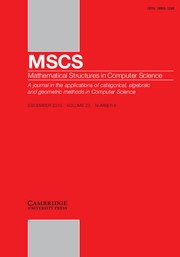Article contents
A generalization of the Takeuti–Gandy interpretation
Published online by Cambridge University Press: 20 February 2015
Abstract
Core share and HTML view are not available for this content. However, as you have access to this content, a full PDF is available via the ‘Save PDF’ action button.
We present an interpretation of a version of dependent type theory where a type is interpreted by a Kan semisimplicial set. This interprets only a weak notion of conversion similar to the one used in the first published version of Martin-Löf type theory. Each truncated version of this model can be carried out internally in dependent type theory, and we have formalized the first truncated level, which is enough to represent isomorphisms of algebraic structure as equality.
- Type
- Paper
- Information
- Copyright
- Copyright © Cambridge University Press 2015
References
Aczel, P. (1978) The type theoretic interpretation of constructive set theory. Logic Colloquium
77
55–66.Google Scholar
Altenkirch, T. (1999) Extensional equality in intensional type theory. In: 14th Symposium on Logic in Computer Science, 412–420.Google Scholar
Altenkirch, T., McBride, C. and Swierstra, W. (2007) Observational equality, now! In: PLPV '07: Proceedings of the 2007 Workshop on Programming Languages Meets Program Verification, ACM 57–68.CrossRefGoogle Scholar
Awodey, S. and Warren, M. (2009) Homotopy theoretic models of identity types. Mathematical Proceedings of the Cambridge Philosophical Society
146
45–55.Google Scholar
Bezem, M., Coquand, Th. and Huber, S. (2014) A model of type theory in cubical sets. In: Matthes, R. and Schubert, A. (eds.) Proceedings of the 19th International Conference on Types for Proofs and Programs (TYPES 2013), Dagstuhl, Germany, 107–128.Google Scholar
Bishop, E. (1967) Foundations of Constructive Analysis, Ishi Press International, 2012, reprinted from the original version MacGraw-Hill.Google Scholar
Church, A. (1940) A formulation of the simple theory of types. Journal of Symbolic Logic
5
56–68.Google Scholar
De Bruijn, N. G. (1980) A survey of the project AUTOMATH. In: H.B. Curry: Essays on Combinatory Logic, Lambda Calculus and Formalism, Academic Press
579–606.Google Scholar
Dubucs, J.-P. (1988) Brouwer: Topologie et constructivisme. Revue d'histoire des Sciences
41
(2)
133–155.Google Scholar
Gandy, R. (1953) On Axiomatic Systems in Mathematics and Theories in Physics, Ph.D. thesis, University of Cambridge.Google Scholar
Gandy, R. (1956) On the axiom of extensionality -Part I. The Journal of Symbolic Logic
21
36–48.CrossRefGoogle Scholar
Girard, J. Y. (1971) Une extension de l'interprétation de Gödel à l'analyse et son application à l'élimination des coupures dans l'analyse et la théorie des types. In: Fenstad, J. E. (ed.) Proceedings of the Second Scandinavian Logic Symposium, North-Holland 63–92.Google Scholar
Hofmann, M. (1994) Extensional Concepts in Intensional Type Theory, Ph.D. thesis, Edinburgh.Google Scholar
Kapulkin, C., Lumsdaine, P. L. and Voevodsky, V. (2012) The simplicial model of univalent foundations. Preprint, http://arxiv.org/abs/1211.2851.Google Scholar
Licata, D. and Harper, R. (2012) Canonicity for 2-dimensional type theory. In: POPL '12: Proceedings of the 39th Annual ACM SIGPLAN-SIGACT Symposium on Principles of Programming Languages, ACM 337–348.Google Scholar
Martin-Löf, P. (1971) Haupsatz for intuitionistic simple type theory. In: Proceeding of the Fourth International congress for Logic, Methodology, and Philosophy of Science, Bucharest, 279–290.Google Scholar
Martin-Löf, P. (1972) An intuitionistic theory of types. In: Sambin, G. and Smith, J. (eds.) published in the volume 25 Years of Type Theory
Google Scholar
Martin-Löf, P. (1973) An intuitionistic theory of types: Predicative part. Logic Colloquium, 73–118.Google Scholar
Martin-Löf, P. (1975) About models for intuitionistic type theories and the notion of definitional equality. In: Proceedings of the Third Scandinavian Symposium, North-Holland.Google Scholar
Mines, R., Richman, F. and Ruitenburg, W. (1988) A Course in Constructive Algebra, Springer.Google Scholar
Palmgren, E. (2012) Proof-relevance of families of setoids and identity in type theory. Archive for Mathematical Logic
51
35–47.Google Scholar
Russell, B. (1906) The theory of implications. American Journal of Mathematics
28
(2)
159–202.Google Scholar
Statman, R. (1985) Logical relations and the typed lambda-calculus. Information and Control
65
85–97.Google Scholar
Streicher, T. (2011) A model of type theory in simplicial sets. Unpublished notes available at the author's home page http://www.mathematik.tu-darmstadt.de/~streicher/sstt.pdf.Google Scholar
Tait, W. (1967) Intensional interpretations of functionals of finite type I. Journal of Symbolic Logic
32
198–212.Google Scholar
Takeuti, G. (1953) On a generalized logic calculus. Japanese Journal of Mathematics
23
39–96.Google Scholar
Troelstra, A. S. and van Dalen, D. (1988) Constructivism in Mathematics. An Introduction, volume 2, North-Holland.Google Scholar
- 4
- Cited by


